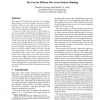HOTOS
1999
IEEE
14 years 3 months ago
1999
IEEE
Modern file systems associate the deletion of a file with the release of the storage associated with that file, and file writes with the irrevocable change of file contents. We pr...
HOTOS
1999
IEEE
14 years 3 months ago
1999
IEEE
Many networked applications could benefit from executing closer to the data or services with which they interact. By doing this they may be able to circumvent long communication l...
HOTOS
1999
IEEE
14 years 3 months ago
1999
IEEE
A Web proxy must accurately predict network performance between itself and its servers and clients in order to make good distillation decisions. In this paper, we show that the cu...
HOTOS
1999
IEEE
14 years 3 months ago
1999
IEEE
Reducing the energy consumed in the use of computing devices is becoming a major design challenge. While the problem obviously must be addressed with improved low-level technology...
HOTOS
1999
IEEE
14 years 3 months ago
1999
IEEE
HOTOS
1999
IEEE
14 years 3 months ago
1999
IEEE
Caching in the Placeless Documents system poses new challenges because users can attach active properties to documents. Active properties can modify the document's content as...
HOTOS
1999
IEEE
14 years 3 months ago
1999
IEEE
Today's fast-growing data-intensive network services place heavy demands on the backend servers that support them. This paper introduces ISTORE, an intelligent server archite...
HOTOS
1999
IEEE
14 years 3 months ago
1999
IEEE
Several operating systems projects revolve around moving functionality above or below the kernel "red line" to increase flexibility or performance. We describe how a gen...
HOTOS
1999
IEEE
14 years 3 months ago
1999
IEEE
Most modern I/O systems treat each file access independently. However, events in a computer system are driven by programs. Thus, accesses to files occur in consistent patterns and...
HOTOS
1999
IEEE
14 years 3 months ago
1999
IEEE


